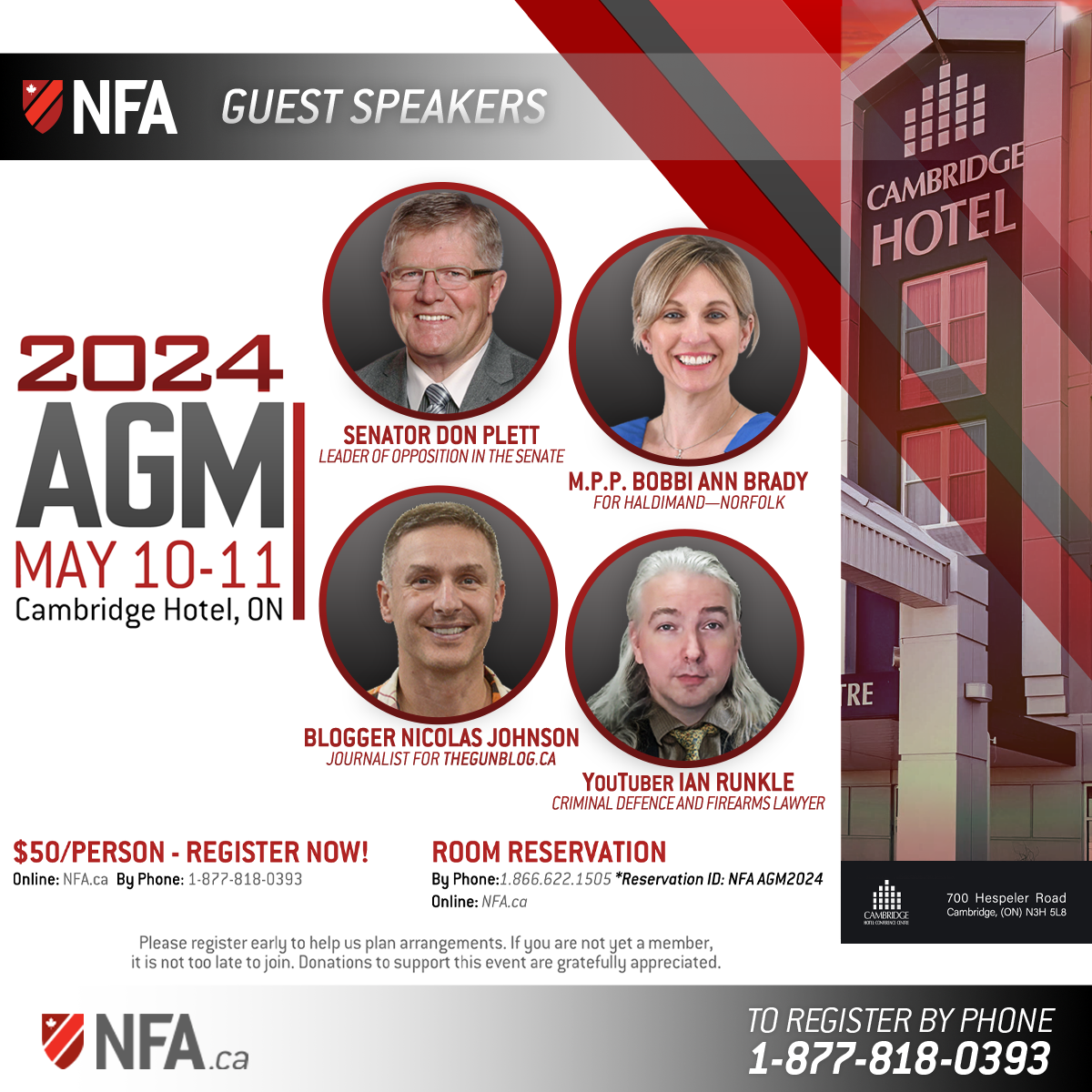Barrel and Firearms Lengths
An unholy mess has been made by earlier legislation plus Bill C-68 regarding the definitions of non-restricted firearms, “restricted firearms”, “prohibited firearms” [the two in quotes are defined by CC s. 84(1); the term non-restricted is not defined in the law]. Let’s try it this way, for the education of those who want to understand this area of law:
NOTE: NONE OF THIS POSTING APPLIES TO ANY FULL AUTO FIREARM, BECAUSE ALL FULL AUTO FIREARMS ARE “PROHIBITED FIREARMS” BY CC S. 84(1) DEFINITION.
LESS THAN 18.5″/470mm BARREL LENGTH RULES:
CC s. 84(1) “restricted firearm” (b): If a firearm has a barrel length less than 18.5″/470mm AND is centrefire AND is semi-automatic, that combination forces the firearm into the “restricted firearm” class. In such a case, IT DOES NOT MATTER HOW THE BARREL ARRIVED AT THAT LENGTH. The rule is the same regardless of how it ARRIVED at the too-short length — but note carefully that this rule is overridden by the rule just below if the barrel is SHORTENED BY CUTTING IT DOWN OR BY SUBSTITUTION to less than 18″/457mm. That is a case of “the specific overrides the general.”
Therefore, a Browning Auto-5 or Remington Model 11-87 shotgun with an 18-5/8″/474mm barrel is non-restricted. Cut the barrel to 18-1/4″/464mm and it becomes a “restricted firearm.” Cut it again — to 17-7/8″/454mm — and it becomes a “prohibited firearm.” It is amazing how cutting 3/8″/10mm rings off its barrel changes the basic character of the firearm, with less than an inch of overall length change!
If you then refit the firearm with a 20″ barrel, it becomes a non-restricted firearm again. It doesn’t HAVE to make sense, it’s GOVERNMENT POLICY.
LESS THAN 18″/457mm BARREL LENGTH RULES:
CC s. 84(1) “prohibited firearm” (d): If the barrel has been SHORTENED to less than 18″/457mm, after leaving the factory, “by sawing, cutting or ANY other alteration or modification” that forces the firearm into the “prohibited firearm” class.
NOTE: The firearm is NOT forced into the “prohibited firearm” class if it left the factory with the barrel at below-18″/457mm barrel length. I have, for example, a .22 rimfire semi-auto 30-shot rifle with a 9-3/4″ barrel, a .410 single-shot shotgun with an 11-3/4″ barrel, two 12-gauge pump-action shotguns with 14″ barrels, a .22 rimfire pump-action rifle with a 17-7/8″ custom barrel and a .223 calibre rifle with a 14″ barrel — AND ALL OF THEM ARE NON-RESTRICTED. THAT IS BECAUSE THEY EITHER LEFT THE FACTORY WITH THOSE BARRELS, OR WERE FITTED WITH FACTORY- OR CUSTOM-MADE BARRELS IN THOSE LENGTHS AT SOME LATER DATE, and were NEVER fitted with a longer barrel. One left the factory with NO barrel, and so a 14″ barrel could be legally fitted.
My assembly of that collection of idiocy demonstrations was deliberate. The law apparently tried to prohibit certain lengths of barrel or firearm — and failed miserably, because the limits are all conditional. Assembling the necessary parts to change one of your firearms into one of my above-noted configurations is something you can do as a hobby. It is a risky hobby. You may be forced to defend the legality of what you have, or have done, in a court of law — at heavy expense — because some police officer does NOT understand all the above technicalities. You may even be convicted — because some JUDGE does not understand firearms law. Did YOU understand it before reading ALL of this posting? Are you SURE you understand the limits NOW?
It is IMPORTANT to understand what you can and cannot do.
OVERALL LENGTH LESS THAN 26″/660mm RULES:
CC s. 84(1) “prohibited firearm” (b): This is another clause of the same law — the one cited immediately above — and it applies in the same way. If the firearm ARRIVES at the “less than 26″/660mm in overall length” condition by “sawing, cutting” etc., then it is forced into the “prohibited firearm” class. If it left the factory at that too-short length, the limit does NOT apply. It is non-restricted, UNLESS it is semi-automatic AND centrefire.
Example: A Remington Model 870 pump-action shotgun that has been fitted with a Scattergun Technologies 12″/305mm barrel and a Pachmayr pistol grip is less than 26″/660mm in overall length, but is NOT “prohibited.” It is a “prohibited firearm” if this was done to a Remington 870 that left the factory with those parts, but it is non-restricted if it was re-manufactured and left the Scattergun Technologies factory with them. It doesn’t HAVE to make sense — it’s GOVERNMENT POLICY.
Note that WHICH class the short firearm becomes — non-restricted, “restricted” OR “prohibited” — depends upon HOW it ARRIVED at that shortened length. That strongly reinforces what I have said above about the length determination — overall OR barrel length — NOT being enough to decide which class the firearm falls into. Knowing the WAY the firearm or barrel ARRIVED at that short length is vital to understanding this area of the law when determining the class of firearm.
I hope that this clarifies the situation for you — as much as is possible with such badly-written law.
Note that a “firearm” is defined, in CC s. 2 “firearm,” as: “a barrelled firearm from which any shot, bullet or other projectile can be discharged and that is capable of causing serious bodily injury or death to a person, and includes any frame or receiver of such a barrelled firearm and anything that can be adapted for use as a firearm.”
What that means is that the “frame or receiver” is a firearm. If you add more uncontrolled ‘spare parts’ to the basic “firearm” (the “frame or receiver”), it is STILL a “firearm.”
You are NOT required to register ‘uncontrolled spare parts.’ There is no way to identify such parts — they usually do not have Serial numbers. You are NOT required to register anything but the “firearm” — and that means only the “frame or receiver.”
You may convert all registrations you now hold to registrations of the “frame or receiver” — and that will make your registration far more flexible. The firearms control bureaucracy has added a special subdivision — “frame or receiver ONLY.” That is NOT how a “frame or receiver” should be registered if there is even one screw attached to it. It should be registered as a partial firearm, NOT a “frame or receiver ONLY.” The government’s computer program cannot handle that variation, because the software is poorly designed and written, but that is what it should be registered as.
Whether or not a firearm is registered, the CLASS that the firearm falls into is controlled by the descriptions given in the current CC s. 84(1) “firearm”, “restricted firearm” and “prohibited firearm” definitions.
There are no definitions of non-restricted firearm or deactivated firearm.
The definition of “firearm” is crippled in current law by the CC s. 2 “firearm” definition, and by the C-68 CC s. 84(3) conditional and partial redefinition of the words “firearm”, “restricted firearm” and “prohibited firearm.”
STUDY all this stuff. Yes, you CAN understand it. Firearms control law is NOT a can of worms. It is a barrel of rattlesnakes.



